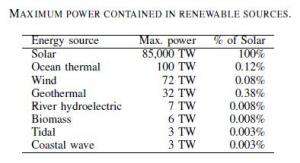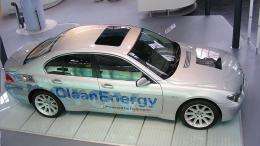August 24, 2009 weblog
How a Solar-Hydrogen Economy Could Supply the World's Energy Needs

(PhysOrg.com) -- As the world's oil supply continues to dry out every day, the question of what will replace oil and other fossil fuels is becoming more and more urgent. According to the World Coal Institute, at the present rate of consumption, coal will run out in 130 years, natural gas in 60 years, and oil in 42 years. Around the world, researchers are investigating alternative energy technologies with encouraging progress - but the question still remains: which source(s) will prove to be most efficient and sustainable in 30, 50, or 100 years from now?
For Derek Abbott, Professor of Electrical Engineering at the University of Adelaide in Australia, the answer is clear. In an invited opinion piece to be published in the Proceedings of the IEEE, Abbott argues that a solar-hydrogen economy is more sustainable and provides a vastly higher total power output potential than any other alternative. While he agrees with the current approach of promoting a mix of energy sources in the transition period toward a sustainable energy technology, he shows that solar-hydrogen should be the final goal of current energy policy. Eventually, as he suggests, this single dominant solution might supply 70% of the world's energy while the remaining 30% is supplied by a mix of other sources.
"My starting point is as an academic who always thought nuclear was the answer, but who then looked at the figures and came to an inescapable conclusion that solar-hydrogen is the long-term future," Abbott told PhysOrg.com. "I did not come at this as a green evangelist. I am a reluctant convert. I deliberately don't even mention the word CO2 once in my paper, in order to demonstrate that one can justify solar-hydrogen simply on grounds of economic resource viability without any green agenda."
In his paper, Abbott begins by providing an overview of the major non-renewable and renewable energy sources. To briefly summarize:
Nuclear fission: While nuclear fission power plants may at first seem to have the economic advantage, they have "hidden costs" (the biggest being the $6 billion cost to decommission after a 30- or 40-year lifetime). In addition, nuclear fission isn't sustainable: if fission hypothetically supplied the world's energy needs, there would only be five years' supply of uranium; and thorium, a suggested substitute, has a recoverable supply of only half of the world's uranium reserves.
Nuclear fusion: Abbott argues that nuclear fusion, which usually involves the fusion of deuterium and tritium, is not actually clean or sustainable. In addition to suffering from the same hidden costs as fission, tritium is considered dangerous enough to require weekly cleaning (as in the case of the International Thermonuclear Experimental Reactor). Plus, tritium is bred by reacting neutrons with lithium; Abbott estimates that the world's lithium reserves would last about 100 years if it were to supply the world's energy along with continuing use in industrial applications, such as batteries, glass, ceramics, and lubricants.
Wind: Abbott explains that wind actually comes from the sun (since the sun heats the ground creating massive convection currents, meaning that wind is a diluted form of solar power), although he shows that wind power is economically uncompetitive with solar power in all locations except cold regions with poor sun levels. Further, a typical 1.5-MW wind turbine requires 20 gallons of lubricating oil every 5 years, which would become unsustainable in a few decades.

On a related note, Abbott emphasizes that we need to preserve at least some of our remaining oil for uses other than energy - such as lubricating the world's engines, as well as for making dyes, plastics, and synthetic rubber. Likewise, natural gas has industrial applications for making ammonia, glass and plastics, and coal for making soap, aspirin, tires, and other materials.
Hydroelectric: Hydroelectricity currently provides 20% of the world's electricity, with room for further growth. However, hydroelectricity could not supply the whole world's power due to the limited availability of waterways. Plus, dams often have negative effects on aquatic ecosystems, as well as tourism, fisheries, and transport. Abbott also notes that, like wind, hydroelectric power is ultimately powered by the sun (via rain), a reminder that tapping the sun directly can offer large amounts of power.
Geothermal: Pumping water below the Earth's crust to create steam that can be used to generate electricity, geothermal power has shown to be cost-effective and sustainable, due to the large amounts of heat contained in the Earth. The downside, Abbott says, is that much of the energy is diffuse and unrecoverable, so that geothermal power could ultimately supply only a fraction of the world's energy needs. In some cases, geothermal is also known to trigger unwanted seismic activity, and can bring toxic chemicals, such as hydrogen sulphide, arsenic, and mercury, to the Earth's surface.
Solar: For Abbott, the unambiguous leader of alternative energy sources is solar power, especially low-tech solar thermal collectors rather than high-tech silicon solar cells.
Today, the world's energy consumption is currently 15 TeraWatts (TW) (15 x 10^12 watts). The total solar energy that strikes the Earth is 166 Petawatts (PW) (166 x 10^15 watts). Even with 50% of this energy being reflected back into space or absorbed by clouds, the remaining 83 PW is more than 5,000 times our present global energy consumption. In contrast, the above sources of renewable energy (wind, hydroelectric, and geothermal) can supply less than 1% of solar power potential. The challenge, of course, is how to harness this large source of renewable, sustainable solar energy.
"The fact that there simply is 5,000 times more sun power than our consumption needs makes me very optimistic," Abbott said. "It's a fantastic resource. We have the ingenuity to send man to the moon, so we definitively have the ingenuity to tap the sun's resources."
Despite the improvements in silicon solar cells, Abbott argues that they suffer from low efficiencies and high environmental impact compared with solar thermal collectors. Solar cells require large amounts of water and arsenic; Abbott calculates that manufacturing enough solar cells to power the world would require 6 million tonnes of arsenic, while the world's supply is estimated at about 1 million tonnes. Even the overall solar cell design is fundamentally flawed, he says. Solar cell semiconductor reliability drops as temperature increases, yet large temperature differences are required to increase thermodynamic efficiency. For this reason, semiconductor technology is much better suited to lower powers and temperatures, such as pocket calculators.
On the other hand, solar thermal collectors are specifically designed to operate under hot temperatures. The idea is to use a curved mirror to focus sunlight to boil water and create steam, which is then used to power, for example, a Stirling heat engine to produce electricity. The system has already been demonstrated in California's Mojave Desert, which has been using a solar thermal system to heat oil in a closed-cycle instead of water for the past 20 years.

Abbott calculates that, in order to supply the world's energy needs, the footprint of such a system with pessimistic assumptions would be equivalent to a plot of land of about 1250 km by 1250 km - about 8% of the land area of the hot deserts of the world. With less pessimistic assumptions, the land area could be reduced to 500 km by 500 km, corresponding to 1.7 billion solar dishes that are each 10 meters wide. At massive volumes, if these Stirling engine dishes could be produced at a cost of $1,000 each, the total world cost would be $1.7 trillion - "which is less than the going rate of a war these days," Abbott noted. He also believes that further cost savings can be made by considering 30-meter diameter dishes, driving much larger Rankine engines, in order to reduce overhead and maintenance costs.
Ideally, Abbott says, solar farms should be distributed widely throughout the world in order to avoid geopolitical stresses and minimize transportation costs. Solar farms of one or two square km could be built in deserts in many regions: the Americas, Africa, Australasia, Asia, and the Middle East.
Hydrogen: After connecting these solar farms to the local electricity grid, the electricity could then be used to electrolyze water to produce liquid hydrogen to run our vehicles. Abbott suggests that the next step would be to power public transport, such as buses, using liquid hydrogen. Then consumers could buy liquid hydrogen cars and refuel at public transport depots for a transition period until existing gasoline stations begin providing liquid hydrogen refueling.
"Governments should begin by setting up sizable solar farms that supplement existing grid electricity and provide enough hydrogen to power buses," Abbott said. "Enthusiasts will then buy hydrogen cars, retrofit existing cars, and refuel at bus depots. Then things will grow from there. You gotta start somewhere."
According to Abbott, running vehicles on hydrogen rather than electricity is superior in terms of sustainability. The batteries in electric vehicles consume chemicals and finite resources such as lithium, and release high levels of toxic waste. On the other hand, vehicles that burn hydrogen simply emit clean water vapor, and do not require the unsustainable use of chemicals. Other advantages of hydrogen vehicles are that today's gasoline combustion engines can be retrofitted to run on hydrogen, and the car manufacturing industry has infrastructure tailored to combustion technology.
"With solar-hydrogen, questions of safe handling are not the issue," Abbott said. "Industry already uses 50 million tonnes of hydrogen annually, and so storage and handling are well-trodden areas. The BMW company has demonstrated the hydrogen combustion engine in a family-sized car [the BMW Hydrogen 7]. Also, 20% of buses in Berlin use hydrogen combustion."

Despite the advantages, hydrogen fuel technology still faces challenges. For instance, the electrodes used in water electrolysis are currently coated with platinum, which is not a sustainable resource, and researchers are currently investigating other materials. Other issues include transporting hydrogen - a recent study has shown that it is more economical to deliver hydrogen by truck to refueling stations rather than perform on-site electrolysis.
Another hurdle is storage - in terms of sustainability, Abbott suggests that the most straightforward approach is to liquefy the hydrogen. Although liquefying hydrogen requires an additional energy cost, Abbott argues that the scenario should not be mistaken for a zero-sum game as is the case with fossil fuels. Since the sun supplies a virtually unlimited amount of energy, the solution is to factor in the non-recurring cost of extra solar collectors to provide the energy for liquefaction. His calculations show that the cost of a solar collector farm used to produce hydrogen is still lower than a nuclear station of equivalent power.
Overall, Abbott's message is that there exists a single technology that can supply the world's energy needs in a clean, sustainable way: solar-hydrogen. The difference in his approach compared to other analyses, he explains, is his long-term perspective. While nuclear power is often cited to be the economically favorable technology in the short-term, Abbott argues that the long-term return on nuclear power is virtually zero due to its limited lifetime, while solar-hydrogen power can theoretically last us the next one billion years.
"The biggest challenge is escaping from the economic effects of vendor lock-in where large investments in nuclear and traditional energy sources keep us 'locked-in' to feeding monsters that will bring us down an economic black hole," Abbott said. "It's rather like the play The Little Shop of Horrors where a man-eating plant is initially fed small amounts, but then its voracious appetite sends it into a downward spiral swallowing up anyone that gets in its way."
Of course, Abbott's analysis is just one approach in the ongoing debate on the advantages and disadvantages of hydrogen. Among several reviews published in a special issue of the Proceedings of the IEEE in October 2006 is an analysis by Ulf Bossel, which shows that a hydrogen economy is uncompetitive due to the energy costs of storage, transportation, etc. Abbott agrees that hydrogen is not an efficient energy storage method, but he also points out that energy from the sun is virtually unlimited, and more solar collectors could make up for the inefficiency of hydrogen technology.
"The Bossel paper did not consider the case of using sun to generate the hydrogen," Abbott said. "So, of course all the inefficiencies added up and hydrogen looked bad compared to fossil fuels. But the point about solar energy is that there is so much of it that you only have to tap 5% of it at an efficiency as tiny as 1% and you already have energy over 5 times the whole world's present consumption.
"This demonstrates that efficiency is not the issue when you go solar. There is so much solar that all you have to do is invest in the non-recurring cost of more dishes to drive a solar-hydrogen economy at whatever efficiency it happens to sit at. I show in my paper that if you do this you come out cheaper than nuclear and you take up less than 8% of the world's desert area. ... So let's begin now, what are we waiting for?"
More information: Derek Abbott. "Keeping the energy debate clean: How do we supply the world's energy needs?" Proceedings of the IEEE. To be published.
• Join PhysOrg.com on Facebook!
• Follow PhysOrg.com on Twitter!
© 2009 PhysOrg.com
















